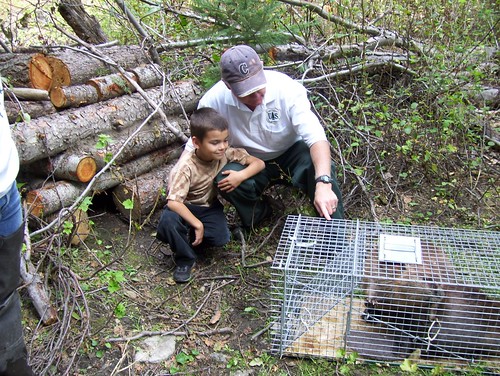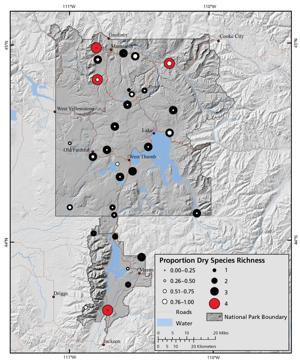 CUMBERLAND RI – It was just about a year ago when members of the Cumberland Land Trust figured out that flooding on their Atlantic White Cedar Swamp trail wasn’t caused by heavy rains.
CUMBERLAND RI – It was just about a year ago when members of the Cumberland Land Trust figured out that flooding on their Atlantic White Cedar Swamp trail wasn’t caused by heavy rains.
This trail off Nate Whipple Highway utilizes a colonial-era cart path along the side of the swamp that crosses a stone culvert thought to have been installed 200-plus years ago.
At first trust members poking around the flood waters last summer simply cleaned out the culvert crammed with mud and twigs.
“Then we came back the same afternoon and it was all plugged up again,” says member Frank Matta. “We thought at first it had been vandalized.”
It was about then that someone suggested beavers. “It hadn’t dawned on us until that moment,” Matta said this week.
Oh those beaver rascals! Plugging the hole you dug in their habitat so that all their precious water didn’t escape. You do know that their are answers to this kind of problem, right?
The group has also called in Michael Callahan of Beaver Solutions in South Hampton, Mass. He’s proposing a piping system that will allow drainage through a hole in the dam. The company claims to have resolved more than 1,000 beaver problems in the United States since 1998 by installing flow devices that keep water draining without alerting the beavers. The Cumberland Land Trust is looking at spending about $1,700 for the installation plus a yearly maintenance fee.
Whooohooo! Rhode Island hires Massachusetts! I don’t think we’ve ever had a positive beaver story from there. But here’s a grand example! Remember that RI is an island so the article says that after beavers were trapped out these ones swam through the Atlantic after being reintroduced in Connecticut. Cool.
And I haven’t even shown you my favorite part of the story. Ready?
East Sneech Pond Brook connects the town’s Sneech Pond Reservoir to the swamp then flows east to Pawtucket’s southern reservoir in Arnold Mills.
Sneech pond? Really? Dr. Seuss would be so proud.

And an awesome letter from Ontario in Parry Sound.com, I’ll reprint here in full.
I read with interest the article that appeared in the July 20 issue of the Parry Sound North Star regarding the washout on Clear Lake Road. According to the article, the washout was caused after the nearby resident beavers were killed, as evidenced by the photos of a dead adult in the ditch and a drowned young.
As an individual who has had some experience with beavers, who are often labelled “nuisance animals” I feel compelled to write.
Beavers are nature’s engineers. They live peacefully in family groups of an adult pair, their last year’s offspring as well as up to three to four infants born early in the spring. The young learn how to create and maintain a dam by mimicking their parents.
It is an acquired skill and one that is learned by trial and error over time. When one or more adults are trapped, as it appears to have happened in this particular case, the young are not yet at a stage where they can maintain a dam properly.
As a result, the dam becomes unstable and breaks, resulting in a tremendous amount of water being rapidly let loose, causing flooding.
Beavers and the role they play in our ecosystems are widely misunderstood.
They create wetlands (which are rapidly disappearing throughout Ontario); beaver activity creates critical habitat for so many other species including fish, otters, muskrat, herons, osprey, moose, bears, ducks, etc. etc. Beavers contribute to biological diversity and regional plant succession regimes; they control the kinetic energy of streams, raise the water table, create canals and generally increase water storage capacity of watersheds.
Mr. Rob Marshall, Seguin Township public works foreman, claims that they hire a trapper to prevent washouts from “nuisance beavers”; however, it would appear that just the opposite happened on Clear Lake Road. Because the adults were trapped and killed, the dam could not be sustained and consequently broke, causing the washout.
In addition, I was informed that a large culvert intended to assist in road maintenance had lain in the ditch for over a year; had it been installed, when the dam broke, there could possibly have been little or no damage done. Instead, I can only guess at the expense involved in the repair of the road and excavating of the culverts; this is taxpayers’ money spent needlessly.
I visited the property of Diane Dow on whose land the beavers had been living peacefully to see for myself the devastation caused by the breaking of the dam.
The site is where three separate watersheds combine into what had been a very large pond – home to many species of fish and animals.
What I saw was muck; I saw a muskrat desperately swimming in a very tiny pool; I saw a mother duck and her ducklings forced to sit in the open and prey to any predators; I saw dead fish; I saw dead water lilies & other vegetation; I heard herons crying desperately searching for fish in the once-abundant pond. The peeper frogs are gone; the turtles are gone. And of course the entire beaver family is gone, either drowned in the washout or trapped. It was heartbreaking.
Quite apart from the environmental destruction, there is another factor involved in this situation (and probably similar ones within the township and elsewhere). The traps were laid in the ditch along a well-used public road and very near a public beach, often travelled by neighbour children and dogs. What would have happened if one of these had encountered the trap instead of the hapless beaver? And the dead beaver was left to rot for three days over the long weekend in July.
To quote from the website of the Fur Bearer Defenders, “Often these issues result in municipalities hiring trappers to kill families of beavers. And while lethal trapping may seem effective, it is only a short-term solution. More beavers will soon come into the area to fill the open niche. This is an especially tragic decision because there are many cost-effective, non-lethal options to prevent flooding from beaver dams”.
As it happens, representatives from Aspen Valley Wildlife Sanctuary and Muskoka Watershed Council are in the process of organizing a workshop for municipalities regarding successful alternatives to control undesirable flooding that may occur due to beaver activity.
The two groups have invited an expert in this regard to head the workshop. The beaver deceiver, beaver baffler and other easily installed devices have proven successful in many regions of Canada and the United States. Last year, one of the programs appearing on The Nature of Things entitled “The Beaver Whisperer” highlighted the vital role that beavers played in our ecosystem and also demonstrated the devices mentioned.
I would respectfully urge the Seguin Mayor and councillors to seriously consider sending representatives to this workshop so that you, as well as other adjacent municipalities can work on implementing long-term solutions that truly work.
It is not necessary to destroy beavers – Canada’s national symbol – and I sincerely hope that this letter will provide more of an understanding of the vital role that this animal plays locally as well as nationally.
Marilyn Cole, Seguin Township







 (Jon got so excited about him that he told Suzi to get a photo, and when she was trying to walk around the edge of the pond she slipped in! About three feet deep because of the swelling tide, but she instinctively held her camera over her head so everything important except her squishy boots was saved! Afterwards Jon was very sorry apologetic.)
(Jon got so excited about him that he told Suzi to get a photo, and when she was trying to walk around the edge of the pond she slipped in! About three feet deep because of the swelling tide, but she instinctively held her camera over her head so everything important except her squishy boots was saved! Afterwards Jon was very sorry apologetic.)

 New research by the U.S. Geological Survey suggests that the effect beavers have on the environment may stem the decline of amphibians in places such as Grand Teton National Park.
New research by the U.S. Geological Survey suggests that the effect beavers have on the environment may stem the decline of amphibians in places such as Grand Teton National Park.


































